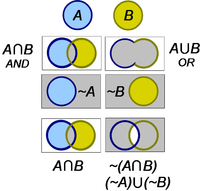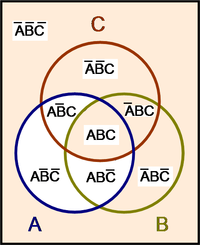Boolean algebra: Difference between revisions
imported>John R. Brews m (→Truth tables: parallel sentence structure) |
imported>John R. Brews (→Truth tables: Extension to logic) |
||
| Line 110: | Line 110: | ||
a combination of stupid people and crooked politicians (of any capacity), whatever choice description might identify this group. | a combination of stupid people and crooked politicians (of any capacity), whatever choice description might identify this group. | ||
==Extension to logic== | |||
The above discussion outlines a method for describing various sets and their subsets, and provides a formal system for deciding when different descriptions of a subset are equivalent. The application of this system to the analysis of logical arguments requires connections, sometimes called ''conditionals'', to constructions such as "if ''A'', then ''B''". Assuming the statements ''A'' and ''B'' are either ''true'' ‘1’ or ''false'' ‘0’ the conditional "implies", denoted by ‘→’ can be defined by the truth table: | |||
{| class="wikitable" style=" text-align:center;" | |||
|+ '''A → B''' | |||
|- | |||
! style="width:15%" | ''A'' | |||
! style="width:15%" | ''B'' | |||
! style="width:15%" | ''A → B'' | |||
|- | |||
| 0 || 0 || style="background:papayawhip; color:blue;font-weight:bold" | 1 | |||
|- | |||
| 0 ||style="background:papayawhip" | 1 || style="background:papayawhip; color:blue;font-weight:bold" | 1 | |||
|- | |||
|style="background:papayawhip" | 1 || 0 ||style="color:blue;font-weight:bold"| 0 | |||
|- | |||
| style="background:papayawhip" | 1 || style="background:papayawhip" | 1 || style="background:papayawhip; color:blue;font-weight:bold" | 1 | |||
|- | |||
|} | |||
In other words, ''A → B'' is false when and only when ''A'' is true and ''B'' is false. This truth table is the same as ''~A + B''. | |||
The ''biconditional'' "equivalence" denoted by ‘↔’ can be defined by the truth table: | |||
{| class="wikitable" style=" text-align:center;" | |||
|+ '''A ↔ B''' | |||
|- | |||
! style="width:15%" | ''A'' | |||
! style="width:15%" | ''B'' | |||
! style="width:15%" | ''A ↔ B'' | |||
|- | |||
| 0 || 0 || style="background:papayawhip; color:blue;font-weight:bold" | 1 | |||
|- | |||
| 0 ||style="background:papayawhip" | 1 || style= "color:blue;font-weight:bold" | 0 | |||
|- | |||
|style="background:papayawhip" | 1 || 0 ||style="color:blue;font-weight:bold"| 0 | |||
|- | |||
| style="background:papayawhip" | 1 || style="background:papayawhip" | 1 || style="background:papayawhip; color:blue;font-weight:bold" | 1 | |||
|- | |||
|} | |||
Thus, ''A ↔ B'' has the same truth table as ''(A → B)·(B → A)''. | |||
With the connections to the implication and equivalence relations between antecedents ''A'' and consequents ''B'', logical constructions can be analyzed. | |||
==References== | ==References== | ||
Revision as of 11:10, 21 July 2011
A Boolean algebra is a form of logical calculus with two binary operations AND (multiplication, •) and OR (addition, +) and one unary operation NOT (negation, ~) that reverses the truth value of any statement. Boolean algebra can be used to analyze computer chips and switching circuits, as well as logical propositions.
Boolean algebra is not a portion of elementary algebra as taught in secondary schools, and is only a facet of algebra, the general mathematical discipline treating variables, symbols and sets.
Boolean algebra has strong connections to the propositional calculus, which relates the truth value of a conclusion to the truth value of the propositions upon which it is based. However, this is only a small, and unusually simple branch of modern mathematical logic.[1]
History
Boolean algebra was introduced in 1854 by George Boole in his book An Investigation of the Laws of Thought.[2] This algebra was shown in 1938 by Claude Elwood Shannon to be useful in the design of logic circuits.[3]
Axioms
The operations of a Boolean algebra, namely, two binary operations on a set A, named AND (multiplication, •) and OR (addition, +), and one unary operation NOT (negation, ~), are supplemented by two distinguished elements, namely 0 (called zero) and 1 (called one) that satisfy the following axioms for any subsets p, q, r of the set A:
The above axioms are redundant, and all can be proven using only the identity, complement, commutative and distributive laws. The distributive law:
may seem at variance with the laws for elementary algebra, which would state:
However, this expression is equivalent within the Boolean axioms above. From the other axioms, p·p = p. Also, p·r + q·p = p·(q + r). This set lies within p, so intuitively p + p·(q + r) = p. Using the Boolean axioms instead of intuition, p + p·(q + r) = p·(1 + q + r) and according to the properties of ‘1’, (1 + q + r) = 1. Thus, the elementary algebraic result, when interpreted in terms of the Boolean axioms, reduces to the Boolean distributive law.
Alternative notations
Some alternative notations for the operations of Boolean algebra include the following:
- && &
Venn diagrams
Venn diagrams provide a graphical visualization of the Boolean operations.[4] The intersection of two sets A∩B plays the role of the AND operation and the union of two sets A∪B represents the OR function, as shown by gray shaded areas in the figure. To introduce the NOT operation, the universal set is represented by the rectangle, so ~A is the set of everything not included in A, corresponding to the gray portion of the rectangle in the third panel on the left.
These diagrams provide a visualization of the Boolean axioms as well. For example, the depiction of ~(A∩B) is readily seen to be the same as (~A)∪(~B), as required by the De Morgan axiom.
Truth tables
A truth table for a logical proposition is a formal way to find whether a conclusion is valid or invalid, with ‘0’ corresponding to "invalid" and ‘1’ to valid. In the context of Boolean algebra, attention is focused upon Boolean functions, denoted f(A, B, C), where variables A, B, C and function f are allowed values ‘1’ or ‘0’ according as the statements they correspond to are valid or invalid. The truth table for f is simply a tabulation of the values of f for all possible values of A, B, C. For example, suppose:
The corresponding truth table is below at the left:
| A | B | C | f |
|---|---|---|---|
| 0 | 0 | 0 | 1 |
| 0 | 0 | 1 | 1 |
| 0 | 1 | 0 | 1 |
| 0 | 1 | 1 | 1 |
| 1 | 0 | 0 | 0 |
| 1 | 0 | 1 | 0 |
| 1 | 1 | 0 | 0 |
| 1 | 1 | 1 | 1 |
The truth table can be set in correspondence with a Venn diagram, as shown to the right. The truth table entry ‘0’ under column A is interpreted as a set of points not in A, while an entry of ‘1’ is taken to refer to points that are contained in A. In the diagram, the notation Ā for ~A is used to keep labeling compact. Labels designate the regions with boundaries surrounding the label, so label ABC denotes the region common to all three sets A, B and C. The colored area encompasses all points corresponding to f = 1, that is all points in the region ~A + B·C, while the white space corresponds to areas outside this region.
In effect, A, B, C are the statements:
- A: Point p is in set A
- B: Point p is in set B
- C: Point p is in set C
and proposition f is:
- f: Point p is either common to sets B and C or not in set A.
The truth table and the Venn diagram decide the validity of f for all choices for validity of A, B, and C.
The Boolean function f can be used with other statements that are closer to everyday language, for example, by substituting concrete entities for the various sets.
- A: Bill is smart
- B: Bill is a politician
- C: Bill is a crook
Then should Bill be a crooked politician and smart (ABC), he would fall into the group f:
- f: ~A + B·C,
a combination of stupid people and crooked politicians (of any capacity), whatever choice description might identify this group.
Extension to logic
The above discussion outlines a method for describing various sets and their subsets, and provides a formal system for deciding when different descriptions of a subset are equivalent. The application of this system to the analysis of logical arguments requires connections, sometimes called conditionals, to constructions such as "if A, then B". Assuming the statements A and B are either true ‘1’ or false ‘0’ the conditional "implies", denoted by ‘→’ can be defined by the truth table:
| A | B | A → B |
|---|---|---|
| 0 | 0 | 1 |
| 0 | 1 | 1 |
| 1 | 0 | 0 |
| 1 | 1 | 1 |
In other words, A → B is false when and only when A is true and B is false. This truth table is the same as ~A + B.
The biconditional "equivalence" denoted by ‘↔’ can be defined by the truth table:
| A | B | A ↔ B |
|---|---|---|
| 0 | 0 | 1 |
| 0 | 1 | 0 |
| 1 | 0 | 0 |
| 1 | 1 | 1 |
Thus, A ↔ B has the same truth table as (A → B)·(B → A).
With the connections to the implication and equivalence relations between antecedents A and consequents B, logical constructions can be analyzed.
References
- ↑ Elliott Mendelson (1970). “Chapter 1: The algebra of logic”, Schaum's Outline of Boolean Algebra and Switching Circuits. McGraw-Hill. ISBN 0070414602.
- ↑ George Boole (1854). An investigation of the laws of thought, on which are founded the mathematical theories of logic and probabilities. Macmillan and Co..
- ↑ For example, see Jonathan Sterne (2003). “Shannon, Claude (1916-2001)”, Steve Jones, ed: Encyclopedia of new media: an essential reference to communication and technology. SAGE Publications, p. 406. ISBN 0761923829.
- ↑ For a discussion, see J. Eldon Whitesitt (1995). “§1-4: Venn diagrams”, Boolean algebra and its applications, Republication of Addison-Wesley 1961 ed. Courier Dover Publications, pp. 5 ff. ISBN 0486684830.









